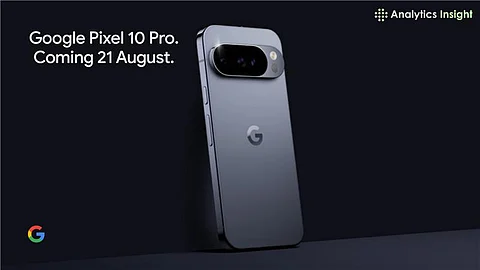

Google has officially announced the launch of its Pixel 10 smartphone series, scheduled for August 20 during its Made by Google event. Considering the time difference, the phones will be on display in India on August 21. This timing puts the devices in direct competition with Samsung's upcoming Galaxy S25 series and Apple's iPhone 17 series, both of which are set to be released in September.
To increase the hype surrounding Pixel phone’s new upgrade, the tech giant has shared a brief teaser video on its website. In the teaser, the new Pixel 10 design looks quite impressive.
The 13-second video features Pixel 10 in a grey colorway, referred to as 'Moonstone.' The animation that transitions the digit '10' into the distinctive horizontal camera bar gives us a glimpse of the design of the new model.
Notably, the camera area includes three lenses, suggesting the addition of a telephoto sensor. This design represents a refinement over previous generations, bringing the Pixel series more in line with multi-camera flagship devices from brands like Apple and Samsung.
Until recently, Google’s high-end Pixel smartphones were typically released in October. The move to advance the launch to August seems strategic. Apple’s iPhone 17, set for launch in September, and Samsung’s Galaxy S25 series, picking up steam, are pushing Google to make a head start in the high-end smartphone category.
Experts argue that this timeline change could provide the Pixel 10 series with a make-or-break window of opportunity to gain traction in the competitive market.
Also Read: What Makes Google Pixel 10 Pro Fold Better Than Samsung Galaxy Z Fold 7?
The Pixel 10 series is also rumored to feature three models: the standard Google Pixel 10, the Google Pixel 10 Pro, and a larger Google Pixel 10 Pro XL. All these variants are predicted to be supported by Google’s in-house Tensor G5 processor, which promises significant upgrades in AI capabilities, power efficiency, and on-device learning.
Screen: 6.3-inch FHD+ OLED, 120Hz refresh rate, Gorilla Glass Victus 2
Brightness: 3,000 nits peak (2,000 nits high-brightness mode)
Cameras: 48MP primary, 12MP ultra-wide (down from 48MP), 10.8MP telephoto
Battery: 4,970mAh
Charging: 29W wired, 15W wireless
Pro Display: 6.3-inch LTPO OLED, 120Hz
Pro XL Display: 6.8-inch LTPO OLED
Cameras (Both Models):
50MP main sensor
48MP ultra-wide
48MP telephoto
Front Camera: 42MP
Battery
Pixel 10 Pro: 4,870mAh
Pixel 10 Pro XL: 5,200mAh
Charging
Pro: 29W wired, 15W wireless + Qi2
Pro XL: 39W wired, 15W wireless
Google Pixel 10 Pro is expected to start at around Rs. 1.1 lakh, while the Pro XL could reach nearly Rs. 1.3 lakh, positioning these devices as premium flagship smartphones. Meanwhile, Samsung's Galaxy S25 range and its foldable models, such as the Z Fold6 and Z Flip7, are already generating significant attention. Apple's iPhone 17 series, set to launch in September, is likely to dominate headlines and attract consumer interest.
At the same time, new competitors are emerging in the foldable segment, including brands like Vivo and OnePlus, which could shorten Google's opportunity to make a significant impact in the market.
Google’s Pixel smartphones have traditionally been software-first phones with niche appeal. With the Pixel 10 family, the company appears to be stepping up its game, both with hardware enhancements and competitive timing, and a bid for a more mainstream design language.
The Tensor G5 chip, high-refresh LTPO screens, and pro-level camera configuration place the Pixel 10 series as serious contenders to Apple and Samsung flagships. Price sensitivity in the Indian market, constrained retail presence, and ongoing service issues might, however, continue to act as breakers.
By adjusting its launch plans and refining its premium offering, Google is signaling that it aims to compete as well as innovate. However, whether Pixel 10 achieves commercial success depends on more than just specifications; pricing, availability, and user experience will ultimately determine if it can stand alongside other flagship smartphones.
Also Read: Why are Google Pixel Phones Good for Gaming?
